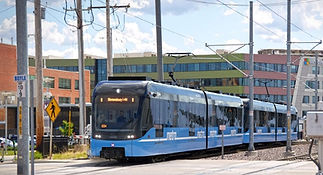Trains aren’t the only things carried on those tracks – it’s also property values.
According to the American Public Transportation Association, property situated near public transportation stations sees its value increase by up to 24%.
For homeowners, this brings a lot of benefit. When you invest in a home, it’s your asset. You want it to grow, not stagnate. Vibrancy and strong transit brings new people to communities, not just because of better value, but because it is actually preferred by many people. A study by Hitachi Rail found a staggering 75% of people in major cities would prefer to live in a city with better public transportation. You don’t just get better value; if you want to sell, you also get a buyer base. But this benefit doesn’t just go to people living in the property they own.
When we bring more ways to travel, that is more foot traffic to local businesses. Hotels filling rooms with guests. Cafes see people popping in for a coffee during their trip. Convenience stores get people grabbing toiletries for the visit. But wait, there’s more!

For local governments, this is a great opportunity to increase the value of the property in their communities (and their revenue). Building multimodal stations (stations with multiple types of transportation available) will provide a greater property value estimate – and this will bring in the money. In Ohio, property tax is calculated using the property’s value. This means more revenue for governments when they do things that encourage rising property values, like building more transit options.
However, this presents a challenge. How do we keep property values from rising too much and becoming unattainable for hopeful buyers in places where transit options are increasing?
The answer is simple: build more.

Transit doesn’t just help increase property values, it encourages more properties to be built. With more development, communities can lower the barriers to entry for new homeowners or businesses by meeting demand with new supply based on the increased options for transportation.
On top of this development, better transportation means saving money elsewhere. It is estimated that Americans can save up to 11 billion dollars on car-related expenses with more reliable and frequent public transit, and businesses can look at increased productivity from expanded labor market access, meaning more profits.

(Image credit American Public Transportation Association)
In short, if you’re looking for:
Increased property values
More business revenue
Better real estate
Then you need more public transportation.
ABOUT ALL ABOARD OHIO
All Aboard Ohio is a non-profit, member-based organization dedicated to promoting improved public transportation and passenger rail service throughout the state.
Founded in 1973 and incorporated as a registered 501c-3 in 1987, All Aboard Ohio has spent more than 50 years advocating, educating, and working towards our goal of a connected Midwest
All Aboard Ohio is a 501c-3 nonprofit with over 50 years of advocacy work, advocating for improved public transportation and passenger rail service in the Midwest
©2025 by All Aboard Ohio
Get in Touch
3136 Kingsdale Center,
#112 Columbus, OH 43221
Federal Tax ID: 31-1066182










